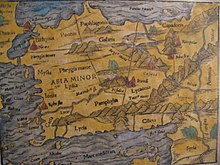Bithynia
| Bithynia (Βιθυνία) | |
|---|---|
| Ancient Region of Anatolia | |
Asia Minor/Anatolia |
Bithynia (
Description
Several major cities sat on the fertile shores of the Propontis (which is now known as
According to
It is occupied by mountains and forests, but has valleys and coastal districts of great fertility. The most important mountain range is the (so-called)
East of this the range extends for more than 100 miles (160 km), from the
The principal rivers are the
The valleys towards the Black Sea abound in fruit trees of all kinds, such as oranges, while the valley of the Sangarius and the plains near Bursa and Iznik (Nicaea) are fertile and well cultivated. Extensive plantations of
History

Iron Age
Bithynia is named for the
Later the Greeks established on the coast the colonies of Cius (modern Gemlik); Chalcedon (modern Kadıköy), at the entrance of the Bosporus, nearly opposite Byzantium (modern Istanbul) and Heraclea Pontica (modern Karadeniz Ereğli), on the Euxine, about 120 miles (190 km) east of the Bosporus.[2]
The Bithynians were incorporated by king
Kingdom of Bithynia
Even before the conquest by
His son and successor,
The coinage of these kings show their regal portraits, which tend to be engraved in an extremely accomplished Hellenistic style.[3]
Roman province
As a
Byzantine province

Under the Byzantine Empire, Bithynia was again divided into two provinces, separated by the Sangarius. Only the area to the west of the river retained the name of Bithynia.[2]
Bithynia attracted much attention because of its roads and its strategic position between the frontiers of the Danube in the north and the Euphrates in the south-east. To secure communications with the eastern provinces, the monumental bridge across the river Sangarius was constructed around 562 AD. Troops frequently wintered at Nicomedia.
During this time, the most important cities in Bithynia were Nicomedia, founded by Nicomedes, and Nicaea. The two had a long rivalry with each other over which city held the rank of capital.
Notable people
- Hipparchus of Nicaea(2nd century BC), Greek astronomer, discovered precession and discovered how to predict the timing of eclipses
- Theodosius of Bithynia (2nd century BC), Greek astronomer and mathematician
- Asclepiades of Bithynia (c. 169 BC – c. 100 BC), Greek physician
- Roman Emperor Hadrian
- senator, and consul
- Arrian (Lucius Flavius Arrianus), Greek historian, c. 86-160
- Helena, mother of Constantine the Great c. 250 – c. 330
- Phrynichus Arabius (2nd century), grammarian
- Auxentius of Bithynia (c. 400 - 473), hermit
- Hypatius of Bithynia (died c. 450), hermit
- Vendemianus of Bithynia (6th century), hermit
See also
References
- ^ a b c d e f g Chisholm 1911, p. 12.
- ^ a b c Chisholm 1911, p. 13.
- ^ "Kings of Bithynia - Asia Minor Coins - Photo Gallery". www.asiaminorcoins.com.
- This article incorporates text from a publication now in the public domain: Chisholm, Hugh, ed. (1911). "Bithynia". Encyclopædia Britannica. Vol. 4 (11th ed.). Cambridge University Press. pp. 12–13.
Further reading
- Hellenistic
- Paganoni, Eloisa (2019). Forging the Crown: A History of the Kingdom of Bithynia from Its Origin to Prusias I. "L'Erma" di Bretschneider. ISBN 978-88-913-1895-4.
- Michels, Christoph (2008). Kulturtransfer und Monarchischer Philhellenismus: Bithynien, Pontos und Kappadokien in Hellenistischer Zeit (in German). Vandenhoeck & Ruprecht GmbH KG. ISBN 978-3-89971-536-1.
- Scholten, Joseph (2019). "Building Hellenistic Bithynia". In Elton, Hugh; Reger, Gary (eds.). Regionalism in Hellenistic and Roman Asia Minor. Ausonius Éditions. pp. 17–24. ISBN 978-2-35613-276-5.
- Roman
- Bekker-Nielsen, Tonnes (2008). Urban Life and Local Politics in Roman Bithynia: The Small World of Dion Chrysostomos. Aarhus Universitetsforlag. ISBN 978-87-7124-752-7. Archived from the originalon 2012-03-01.
- Bowie, Ewen (2022). "Greek High Culture in Hellenistic and Early Imperial Bithynia: Towards a Prosopography of Practitioners of Greek Culture in Bithynia Down to the Middle of the Third Century AD". Mnemosyne. 75 (1): 73–112. ISSN 0026-7074.
- Harris, B. F. (2016). Temporini, Hildegard (ed.). "Bithynia: Roman Sovereignty and the Survival of Hellenism". Aufstieg und Niedergang der römischen Welt. 2.7.2: 857–901. ISBN 9783110860429.
- Marek, Christian (2003). Pontus et Bithynia: die römischen Provinzen im Norden Kleinasiens (in German). Von Zabern. ISBN 978-3-8053-2925-5.
- Storey, Stanley Jonathon (1999) [1998]. Bithynia: history and administration to the time of Pliny the Younger (ISBN 0-612-34324-3. Retrieved 2007-05-21.
- Byzantine
- Darrouzès, Jean, ed. (1981). Notitiae Episcopatuum Ecclesiae Constantinopolitanae. Paris: Institut français d'études byzantines.
- Komatina, Predrag (2014). "Settlement of the Slavs in Asia Minor During the Rule of Justinian II and the Bishopric των Γορδοσερβων" (PDF). Београдски историјски гласник: Belgrade Historical Review. 5: 33–42.
- Ostrogorsky, George (1956). History of the Byzantine State. Oxford: Basil Blackwell.

